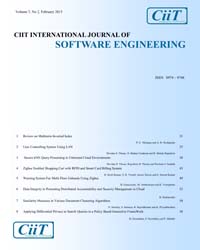Object Oriented Software Architecture – A Survey Approach
Subscribe/Renew Journal
The UML extension is based on design principles that are derived from characteristics of MAS (Multi-Agent Systems) and concept of software architecture which helps to design reusable and well structured multi-agent architecture. The extension allows one to use original object oriented method without syntactic or semantic changes which implies the preservation of OO productivity, i.e., the availability of developers and tools, the utilization of past experiences and knowledge, and the seamless integration with other systems. This survey discusses in more detail how architectures can be described and the uses of such descriptions. Much research so far has also been dedicated to methods and case studies, to make the research of practical interest. This survey describes how the quality of the software can be ensured to a certain degree through informal approaches - not least because an architectural description provides a common understanding around which different stakeholders can meet and discuss a system. Formal approaches are also emerging, and there are a number of formal languages for description of a system's software architecture.
User
Subscription
Login to verify subscription
Font Size
Information

Abstract Views: 223

PDF Views: 2



